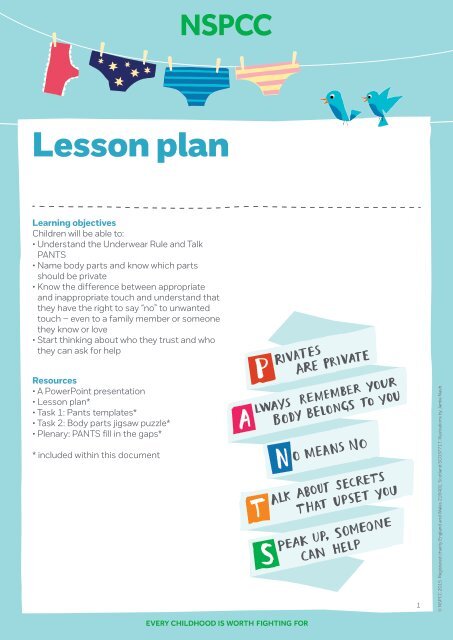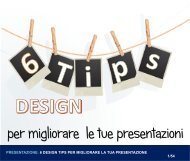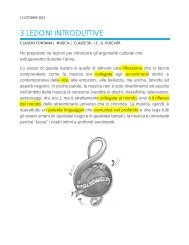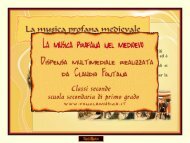underwear-rule-resources---lesson-plan-2015
You also want an ePaper? Increase the reach of your titles
YUMPU automatically turns print PDFs into web optimized ePapers that Google loves.
Lesson <strong>plan</strong><br />
Learning objectives<br />
Children will be able to:<br />
• Understand the Underwear Rule and Talk<br />
PANTS<br />
• Name body parts and know which parts<br />
should be private<br />
• Know the difference between appropriate<br />
and inappropriate touch and understand that<br />
they have the right to say “no” to unwanted<br />
touch – even to a family member or someone<br />
they know or love<br />
• Start thinking about who they trust and who<br />
they can ask for help<br />
Resources<br />
• A PowerPoint presentation<br />
• Lesson <strong>plan</strong>*<br />
• Task 1: Pants templates*<br />
• Task 2: Body parts jigsaw puzzle*<br />
• Plenary: PANTS fill in the gaps*<br />
* included within this document<br />
1<br />
© NSPCC <strong>2015</strong>. Registered charity England and Wales 216401. Scotland SC037717. Illustrations by Jamie Nash.
Running the <strong>lesson</strong><br />
Time required 60 minutes<br />
Open the Powerpoint presentation<br />
Before you start<br />
Take a few moments to ask the pupils to<br />
establish some ground <strong>rule</strong>s for the <strong>lesson</strong>.<br />
These may include things like only one<br />
person talking at once, or not asking<br />
personal questions.<br />
Slide 1: The Underwear Rule<br />
(10 minutes)<br />
1. Introduce the Underwear Rule to the class<br />
– anything that is covered by <strong>underwear</strong><br />
is a private part of our body and check<br />
that all pupils understand what the word<br />
‘private’ means.<br />
2. Show the Underwear Rule poster or image.<br />
3. Show children the PANTS acrostic to<br />
explain the Underwear Rule. Use the PANTS<br />
posters or show our web <strong>resources</strong> on the<br />
whiteboard.<br />
4. Take each sentence in turn and explain<br />
what each letter of PANTS stands for.<br />
Check that the children understand each<br />
phrase. Encourage them to say it out loud<br />
as a chant, if they are familiar with this<br />
learning method, and depending on their<br />
age. This might be harder for younger or<br />
lower ability students.<br />
Slide 2: Design your own pants<br />
(10 minutes)<br />
1. Provide a variety of arts materials so that<br />
the class can design their own pants.<br />
This can include sheets of plain paper,<br />
wrapping paper, tissue paper, colouring<br />
pencils, pens and paints.<br />
2. Task one: working in pairs/small groups<br />
ask children to design and make their<br />
own pants using the pants templates<br />
or by designing their own pants shapes.<br />
Each pair can use one of the PANTS letters<br />
so that there are multiple complete versions<br />
of PANTS to display or use later in task two.<br />
3. Display the pants in the classroom as part<br />
of the ongoing objective to reinforce the<br />
Underwear Rule.<br />
Slide 3: Labelling parts of the body<br />
(10 minutes)<br />
1. Task two: create a large representation of<br />
the human body so that the children can<br />
help to label key body parts and identify<br />
what area is covered by pants (use the<br />
pants from task one for this).<br />
Options include:<br />
• Use the body parts puzzle.<br />
• Have a teacher draw a body shape on<br />
the whiteboard (or a large piece of paper),<br />
or ask for a child to volunteer to do this.<br />
2. Ask the children to help you label each<br />
part of the body. And use this activity<br />
to lead on to discussing the appropriate<br />
language we may use to describe parts<br />
of our body, as per the agreed list (see<br />
additional <strong>resources</strong>). The DfEE Sex and<br />
Relationship Education Guidance 2000<br />
advises that ‘all children are able to name<br />
parts of the body and describe how their<br />
bodies work’. In addition, the DfE Science<br />
Programme of Study Key Stages 1 and<br />
2 National Curriculum in England, Year<br />
1 programme of study, Animals, including<br />
humans asks that pupils ‘identify, name,<br />
draw and label the basic parts of the<br />
human body.’ Introduce this vocabulary<br />
in measured terms when explaining that<br />
the pants region shouldn’t be touched.<br />
Say that there are special circumstances<br />
when touching is OK, which you will<br />
cover next.<br />
2
Slide 4: Good’ and ‘bad’ touch<br />
(10 minutes)<br />
1. As a class discuss the difference<br />
between appropriate/‘good’ touch, and<br />
inappropriate/‘bad’ touch. Inappropriate<br />
touch can include things like pinching,<br />
biting, kicking, scratching, squeezing and<br />
hitting. Explain that touch can be good,<br />
bad or unwanted.<br />
2. Move on to a teacher-led discussion about<br />
positive and negative feelings linked to<br />
‘good’ touch/‘bad’ touch. Say that ‘good’<br />
touch should make you feel positive – like<br />
hugs and kisses from family members.<br />
Talk about why people might touch you:<br />
• to show affection (hugs, kisses, cuddles)<br />
• to keep you safe (holding your hand when<br />
you cross the road)<br />
• if you’re ill or hurt (doctors and nurses)<br />
3. Then talk about touch which maybe doesn’t<br />
feel good but is necessary:<br />
• grabbing you to stop you running into<br />
a busy road, or other danger<br />
• examination by a doctor or nurse<br />
(explain that you can always ask<br />
for a trusted adult to be present)<br />
Reinforce that if someone needs to break<br />
the Underwear Rule, they should explain<br />
why. Children can say no, and it should<br />
never be a secret.<br />
4. Make sure the children understand that<br />
they should not be asked to keep secrets<br />
that involve touch. Give this example:<br />
A parent’s friend comes into your room<br />
and gives you a hug and a kiss, then they<br />
tell you it’s a secret and you shouldn’t<br />
tell anyone.<br />
Explain to pupils that if they are being<br />
asked to keep secrets by people and<br />
don’t understand why, they should talk<br />
to someone they trust about them.<br />
Slide 5: People you can trust<br />
(10 minutes)<br />
1. Lead a discussion and ask the children to<br />
think of different types of helpful people or<br />
professions. Explain that people who you<br />
can trust and who can help might be very<br />
different for different people and COULD<br />
include a parent, a sibling, a friend’s parent,<br />
a teacher, a police officer etc.<br />
2. Task 3: Pupils write a list of people they<br />
trust most. You should offer guidance<br />
on who this might be but make sure this<br />
does not include generalised statements<br />
of people who can definitely be trusted.<br />
Each child should create their own<br />
individual list. Encourage them to make<br />
it more personal. Ask them to think of<br />
people in their life who they feel they<br />
could confide in and trust.<br />
3. Encourage the children to write their<br />
own list and keep it somewhere safe.<br />
Slide 6: Plenary<br />
(10 minutes)<br />
1. Review and reinforce the PANTS acrostic.<br />
See if the children can remember it.<br />
Working in small groups, give each group<br />
one letter from PANTS, and ask them<br />
to say it to the class. Ask the children<br />
to call out key words from PANTS, eg<br />
‘private’, ‘your body’, ‘no’, ‘secrets’, ‘help’.<br />
Encourage the children to use the pants<br />
they designed earlier to consolidate<br />
their understanding.<br />
2. Task 4 (Optional, for older pupils):<br />
Complete the PANTS fill in the gaps.<br />
Give pupils a worksheet with the 5 letters<br />
of PANTS on it, and encourage them<br />
to write the sentences that complete the<br />
acrostic. This could be done individually<br />
or in groups.<br />
5. Finally – ‘bad touch’. Again, this needs<br />
to be teacher-led. Avoid discussions<br />
about abuse, reinforce that if they feel<br />
uncomfortable about touch they can<br />
talk to someone they trust.<br />
You can access a reading list here and details of how<br />
this fits with your curriculum here and on the NSPCC<br />
Underwear Rule web pages<br />
3
Pupil activity<br />
<strong>resources</strong><br />
We’ve put together three activity ideas to<br />
support your <strong>lesson</strong>s about the Underwear Rule.<br />
Task 1: Making pants<br />
• Print out enough copies of the pants<br />
template for pupils to cut out and decorate.<br />
• Each pupil can pick a letter to put on the<br />
pants, so that together they spell out a<br />
message.<br />
• You could use these to put together a<br />
display of the Underwear Rule message.<br />
• They can also be used, if printed to the<br />
right size on A4, to cover the pants area<br />
of the body in task two.<br />
Task 2: Body puzzle<br />
There are a few different options for this<br />
exercise – including drawing a rough body<br />
on a piece of paper, doing the same on<br />
a whiteboard, or creating the shape in<br />
advance, ready for labelling.<br />
Another option is to create a body parts<br />
puzzle, where pupils piece together the<br />
human body from a range of body parts.<br />
Whichever approach you choose, pupils<br />
can then add a pair of pants (using the pants<br />
template from Task 1) – making it clear which<br />
areas are private and reinforcing that part of<br />
the <strong>lesson</strong>.<br />
Body parts should include those that are<br />
not covered by the Underwear Rule.<br />
The aim of the activity is to learn which parts<br />
of the body should remain private – not simply<br />
to learn how to label body parts.<br />
Plenary: PANTS fill in the gaps<br />
This exercise can help to cement learning,<br />
but would only be suitable for older or higher<br />
ability pupils.<br />
© NSPCC <strong>2015</strong>. Registered charity England and Wales 216401. Scotland SC037717. Illustrations by Jamie Nash.
Body parts puzzle
Can you complete the PANTS <strong>rule</strong>?<br />
P<br />
A<br />
N<br />
T<br />
S





